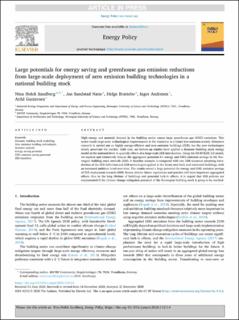| dc.contributor.author | Sandberg, Nina Holck | |
| dc.contributor.author | Næss, Jan Sandstad | |
| dc.contributor.author | Brattebø, Helge | |
| dc.contributor.author | Andresen, Inger | |
| dc.contributor.author | Gustavsen, Arild | |
| dc.date.accessioned | 2021-03-16T10:27:39Z | |
| dc.date.available | 2021-03-16T10:27:39Z | |
| dc.date.created | 2021-03-10T11:13:14Z | |
| dc.date.issued | 2021 | |
| dc.identifier.issn | 0301-4215 | |
| dc.identifier.uri | https://hdl.handle.net/11250/2733588 | |
| dc.description.abstract | High energy and material demand in the building sector causes large greenhouse gas (GHG) emissions. This sector needs large-scale technological improvements in the transition to a future low-emission society. Extensive research is carried out on highly energy-efficient and zero emission buildings (ZEB), but the new technologies slowly penetrate the market. Until now, no bottom-up studies have applied a dynamic building stock energy model at the national level to quantify effects of a large-scale ZEB introduction. Using the RE-BUILDS 2.0 model, we explore and extensively discuss the aggregated potential for energy and GHG emission savings in the Norwegian building stock towards 2050. A Baseline scenario is compared with two ZEB scenarios assuming introduction of the ZEB definition and ZEB technologies applied in the future new built and renovated buildings, with an increased ambition level over time. The results reveal a large potential for energy and GHG emission savings of ZEB deployment towards 2050. Hence, stricter future regulations and practice will have important aggregated effects. Due to the long lifetime of buildings and potential lock-in effects, it is urgent that ZEB policies are implemented if the climate change mitigation potential of the Norwegian building stock is going to be reached. | en_US |
| dc.language.iso | eng | en_US |
| dc.publisher | Elsevier | en_US |
| dc.rights | Navngivelse 4.0 Internasjonal | * |
| dc.rights.uri | http://creativecommons.org/licenses/by/4.0/deed.no | * |
| dc.title | Large potentials for energy saving and greenhouse gas emission reductions from large-scale deployment of zero emission building technologies in a national building stock | en_US |
| dc.type | Peer reviewed | en_US |
| dc.type | Journal article | en_US |
| dc.description.version | publishedVersion | en_US |
| dc.source.journal | Energy Policy | en_US |
| dc.identifier.doi | 10.1016/j.enpol.2020.112114 | |
| dc.identifier.cristin | 1896904 | |
| dc.relation.project | Norges forskningsråd: 257660 | en_US |
| dc.description.localcode | © 2020 The Authors. Published by Elsevier Ltd. This is an open access article under the CC BY license (http://creativecommons.org/licenses/by/4.0/). | en_US |
| cristin.ispublished | true | |
| cristin.fulltext | original | |
| cristin.qualitycode | 1 | |

